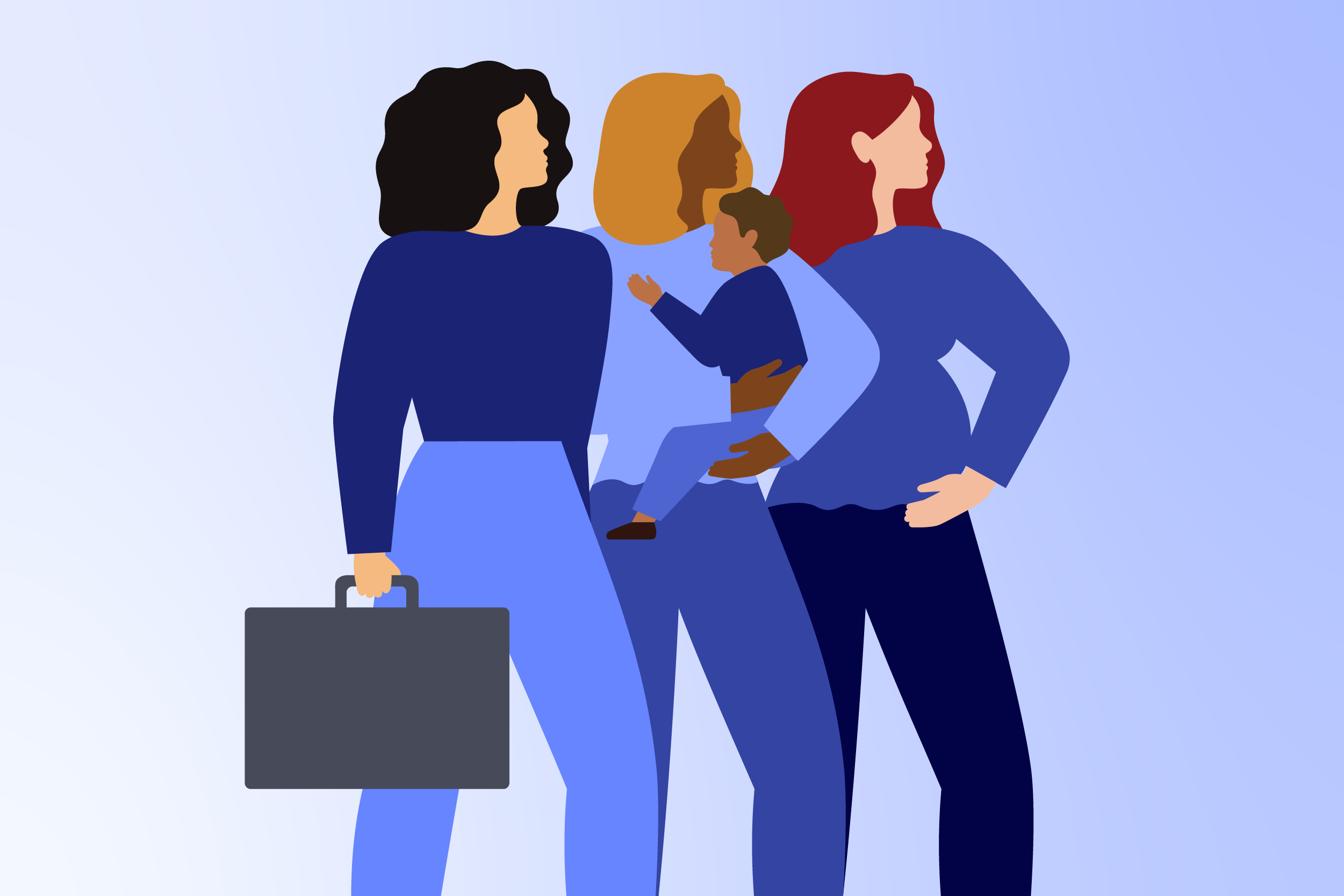Relief is on the way for many Americans. The U.S. government is responding to economic hardships caused by COVID-19, recently passing historic legislation to bring financial assistance to individuals.
The Mom Project is committed to providing accurate, timely information as we navigate this rapidly evolving situation alongside you. Stay tuned for updates …
Last updated April 7, 2020.
There’s a constant word in these ever-changing times.
H E A L T H.
Safer at home, shelter in place, social distancing have us vigilant about physical health.
Wellness initiatives like meditation, a boom in the CBD industry, zoom meetings to stay in touch while we stay in have us vigilant about mental health.
And recent historic legislation that includes a groundbreaking stimulus package for individuals signals the U.S. government is vigilant about our collective economic health in the face of COVID-19.
Read the complete Stride Health x The Mom Project
Independent Worker's Guide to COVID-19.
Keep reading for important highlights ...
CARES Act
(Coronavirus Aid, Relief, and Economic Security Act)
What it is: The newly enacted law includes several elements aimed at helping keep people engaged in the economy. That means direct cash for many, plus expanded unemployment benefits and new rules for things like filing your taxes and making retirement contributions. (Source: NPR)
How much is the stimulus?
- $1,200 / individual -- or -- $2,400 / married
- $500 / child
Who qualifies?
- All U.S. residents with adjusted gross income (AGI) up to $75K
Reduced individual rebates for AGI up to $99K - Married couples filing jointly with AGI up to $150K
Reduced joint filer rebates for AGI up to $198K
More stipulations: Cannot be a dependent of another taxpayer & must have a work-eligible SSN.
How do I get my rebate?
- Payments will be automatic for the vast majority of U.S. citizens that meet eligibility requirements.
- Tax returns (from 2019 if already filed or 2018 if not) will be used to determine payouts.
- Disbursements are handled by the IRS. (Latest IRS news here.)
When will I receive my check?
- The short answer: no one knows yet.
- Experts are estimating from 4 weeks to several months. (More info here.)
How does the Earned Income Tax Credit (EITC) and/or Child Tax Credit (CTC) impact my rebate?
- The rebate is reduced by $5 for every $100 your income exceeds the phase-out threshold.
Rebates phased out at: $99,000 for single filers // $146,500 for head of household filers with one child // $198,000 for joint filers with no children.
FFCRA Act
(Families First Coronavirus Response Act)
What it is: The law includes provisions for employees impacted by coronavirus, including free coronavirus testing, security for food safety programs and boosted unemployment insurance. Additionally, companies with less than 500 employees are required to offer paid sick leave benefits to those affected by COVID-19. Business tax credits are in place to offset these payments. Companies with less than 50 employees may be exempt from these requirements. (Source: Forbes.)
Prohibitions: Employers may not discharge, discipline, or otherwise discriminate against any employee who takes paid sick leave under the FFCRA and files a complaint or institutes a proceeding under or related to the FFCRA.
What are qualifying reasons for leave?
- You are subject to a Federal, State, or local quarantine or isolation order related to COVID-19;
- You have been advised by a health care provider to self-quarantine related to COVID-19
- You are experiencing COVID-19 symptoms and seeking a medical diagnosis;
- You are caring for an individual subject to an order described in (1) or self-quarantine as described in (2);
- You are caring for a child whose school or place of care is closed (or child care provider is unavailable) for reasons related to COVID-19; and are UNABLE TO TELEWORK.
- You are experiencing any other substantially-similar condition specified by the Secretary of Health and Human Services, in consultation with the Secretaries of Labor and Treasury.
What length of leave is protected?
- Reasons 1 - 4 & 6: Full-time employees are eligible for up to 80 hours of leave. Part-time employees are eligible for leave equal to the average number of hours they work over a two-week period.
- Reason 5: Full-time employees are eligible for up to 12 weeks of leave at 40 hours a week. Part-time employees are eligible for leave equal to the number of hours they are normally scheduled to work over a 12-week period.
How is pay calculated?
- Reasons 1 - 3: Employees will be paid at their regular rate (or the applicable minimum wage, whichever is higher) up to $511 / day and $5,110 in the aggregate (over a 2-week period).
- Reasons 4 & 6: Employees will be paid at 2/3 their regular rate (or 2/3 the applicable minimum wage, whichever is higher) up to $200 / day and $2,000 in the aggregate (over a 2-week period).
- Reason 5: Employees will be paid at 2/3 their regular rate (or 2/3 the applicable minimum wage, whichever is higher) up to $200 per day and $12,000 in the aggregate (over a 12-week period: two weeks of paid sick leave followed by up to 10 weeks of paid expanded family and medical leave).
Won’t this be hard on new & small businesses given the current economic uncertainty?
- Employers are protected under FFCRA, too.
- If covered, they qualify for dollar-for-dollar tax credits for all qualifying wages paid under the FFCRA. Qualifying wages = those paid to employees on leave under the Act for qualifying reasons, up to the set per diem & aggregate pay caps.
- Tax credits also cover amounts paid // incurred to maintain health insurance coverage.
- More information from the Department of Labor (DOL) for small & new businesses here.
What else?
- FFCRA poster: The DOL requires employers to post /share this poster with employees. Haven’t seen it yet? If your company employs less than 500 people, remind your HR team to communicate it.
- FFCRA website: Visit the DOL’s Q&A page for all FFCRA-related questions.
More Resources
Unemployment Benefits & Insurance
Considerations for individuals applying for unemployment assistance is 2-fold. (Source: CNBC)
- Additional Funds: The CARES Act provisions an extra $600 per week (up to 4 months) to laid off or furloughed employees, and extends existing state benefits by 13 weeks.
- Self-Employed & Gig Workers Now Qualify: The new Pandemic Unemployment Assistance (PUA) program provides unemployment benefits to those that don’t qualify for traditional Unemployment Insurance (UI), like self-employed and gig economy workers, and those whose hours have been reduced.
Housing Protection
For Renters:
- If your landlord's loan is federally backed*, there's a mandatory nationwide stop to evictions for 4 months (beginning April 1).
- Landlords cannot take legal action to regain possession of a rented unit or to charge fees or penalties to the tenant related to such nonpayment of rent.
For Homeowners:
- Beginning March 18, no foreclosures are allowed for 60 days.
- The legislation requires 180 days of forbearance (extra time to make payments) -- plus another 180 day extension to primary-residence borrowers with federal loans (interest will still accrue).
- The five largest private U.S. banks have agreed to defer mortgage payments for those impacted by the coronavirus outbreak, among other relief options. (More from Forbes here.)
For Landlords:
- Landlords (borrowers that have a federally-backed multifamily mortgage) are allowed 90 days of forbearance.
- Landlords receiving forbearance may not evict or charge late fees to tenants for the duration of the forbearance period.
Tax Deadline Extension
The IRS has extended the tax filing deadline to July 15, 2020. (Source: IRS)
Credit Reporting
Your credit score will not be impacted for utilizing relief programs -- nor if you've made arrangements with a creditor regarding terms, payment delays or skipped payments.
Retirement Accounts
- You can withdraw up to $100K without penalty for "coronavirus-related purposes" if you have to. That money will be taxed for the next 3 years -- but you're also able to pay the funds back over the next 3 years without it going against annual contribution limits.
- Required minimum distributions (RMDs) have been waived for 2020. (More here.)
Student Loan Pause
- Many federal student loan payments will be paused through September 30, 2020, and interest will be waived during that period. Click here to see if your loan is eligible.
- Have a state- or privately-held student loan? Check with your provider, as many of them are offering similar terms.
- Under the new legislation, employers can also contribute up to $5,250 to employees' student loans without that money counting as income. (Source: Ellevest)
Pink Tax Break
All menstrual products are now deemed medical and are eligible for reimbursement through FSA // HSA and other pre-tex employer health programs.
Paid Leave for the United States (PL+US)
Keep up with the PL+US mission to gain paid leave for all Americans here. Their content is of-the-minute and relevant -- as they lobby for high-quality paid family leave for everyone -- every day, and especially in times like these.
While At Home
“Even during unprecedented crisis, employers are hiring across a range of industries.” While At Home, a rigorous volunteer effort by some truly brilliant minds, curated a helpful resource of those regional and national companies to help individuals in a variety of ways. Check it out.
Current News
- NPR: What's Inside The Senate's $2 Trillion Coronavirus Aid Package
- Washington Post: What’s in the $2.2 trillion coronavirus Senate stimulus package
- NY Times: F.A.Q. on Stimulus Checks, Unemployment and the Coronavirus Plan
- Forbes: Stimulus Check Calculator: How Much Will You Receive?
The Mom Project will update this post with relevant information for government supported assistance to individuals as it becomes available / approved. The information here is current to the best of our knowledge and should not be construed as legal advice or guidance.



